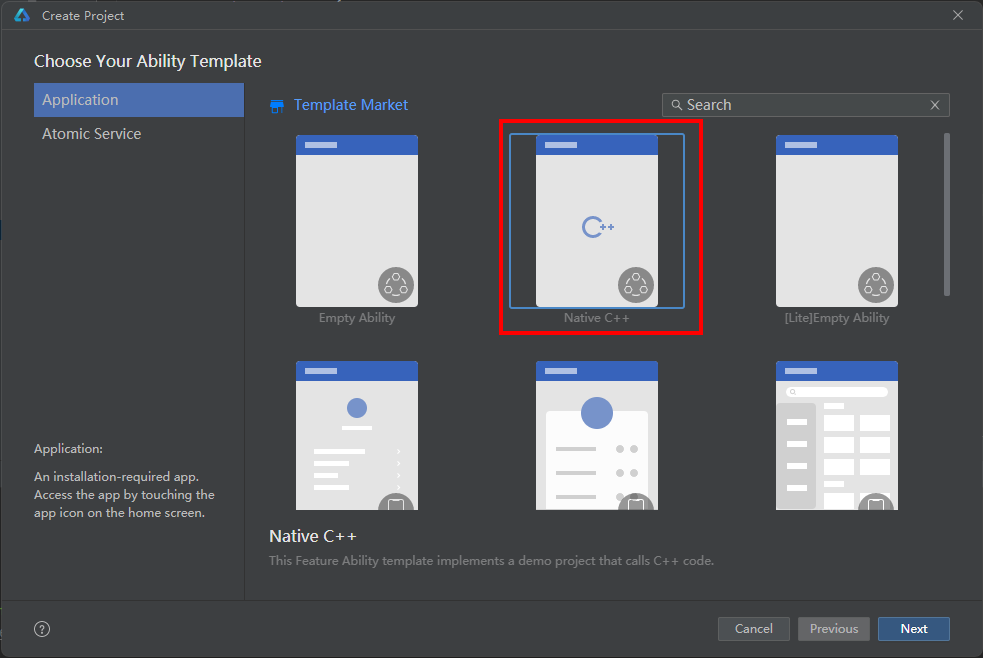NativeBundle开发指导
场景介绍
开发者可以通过本指导了解在OpenHarmony应用中,如何使用Native Bundle接口获取应用自身相关信息。
接口说明
| 接口名 | 描述 |
|---|---|
| OH_NativeBundle_GetCurrentApplicationInfo | 获取应用自身相关信息。 |
| OH_NativeBundle_GetAppId | 获取自身应用的appId信息。 |
| OH_NativeBundle_GetAppIdentifier | 获取自身应用的appIdentifier信息。 |
开发步骤
1. 创建工程

2. 添加依赖
创建完成后,IDE会在工程生成cpp目录,目录有libentry/index.d.ts、hello.cpp、CMakeLists.txt等文件。
-
打开src/main/cpp/CMakeLists.txt,在target_link_libraries依赖中添加包管理的libbundle_ndk.z.so。
target_link_libraries(entry PUBLIC libace_napi.z.so libbundle_ndk.z.so) -
打开src/main/cpp/hello.cpp文件,添加头文件。
#include "bundle/native_interface_bundle.h"
3. 修改源文件
-
打开src/main/cpp/hello.cpp文件,文件Init会对当前方法进行初始化映射,这里定义对外接口为getCurrentApplicationInfo。
EXTERN_C_START static napi_value Init(napi_env env, napi_value exports) { napi_property_descriptor desc[] = { { "getCurrentApplicationInfo", nullptr, GetCurrentApplicationInfo, nullptr, nullptr, nullptr, napi_default, nullptr} }; napi_define_properties(env, exports, sizeof(desc) / sizeof(desc[0]), desc); return exports; } EXTERN_C_END -
把src/main/cpp/hello.cpp文件中,增加对应的方法,如下所示:
static napi_value GetCurrentApplicationInfo(napi_env env, napi_callback_info info) -
在hello.cpp文件中获取Native的包信息对象,并转为js的包信息对象,即可在js测获取应用的信息:
static napi_value GetCurrentApplicationInfo(napi_env env, napi_callback_info info) { // 调用Native接口获取应用信息 OH_NativeBundle_ApplicationInfo nativeApplicationInfo = OH_NativeBundle_GetCurrentApplicationInfo(); napi_value result = nullptr; napi_create_object(env, &result); // Native接口获取的应用包名转为js对象里的bundleName属性 napi_value bundleName; napi_create_string_utf8(env, nativeApplicationInfo.bundleName, NAPI_AUTO_LENGTH, &bundleName); napi_set_named_property(env, result, "bundleName", bundleName); // Native接口获取的指纹信息转为js对象里的fingerprint属性 napi_value fingerprint; napi_create_string_utf8(env, nativeApplicationInfo.fingerprint, NAPI_AUTO_LENGTH, &fingerprint); napi_set_named_property(env, result, "fingerprint", fingerprint); char* appId = OH_NativeBundle_GetAppId(); // Native接口获取的appId转为js对象里的appId属性 napi_value napi_appId; napi_create_string_utf8(env, appId, NAPI_AUTO_LENGTH, &napi_appId); napi_set_named_property(env, result, "appId", napi_appId); char* appIdentifier = OH_NativeBundle_GetAppIdentifier(); // Native接口获取的appIdentifier转为js对象里的appIdentifier属性 napi_value napi_appIdentifier; napi_create_string_utf8(env, appIdentifier, NAPI_AUTO_LENGTH, &napi_appIdentifier); napi_set_named_property(env, result, "appIdentifier", napi_appIdentifier); // 最后为了防止内存泄漏,手动释放 free(nativeApplicationInfo.bundleName); free(nativeApplicationInfo.fingerprint); free(appId); free(appIdentifier); return result; }
4. js侧调用
-
打开src\main\ets\pages\index.ets, 导入"libentry.so"。
-
调用Native接口getCurrentApplicationInfo即可获取应用信息。示例如下:
import hilog from '@ohos.hilog'; import testNapi from 'libentry.so'; @Entry @Component struct Index { @State message: string = 'Hello World'; build() { Row() { Column() { Text(this.message) .fontSize(50) .fontWeight(FontWeight.Bold) Button(){ Text("GetCurrentApplicationInfo").fontSize(30) }.type(ButtonType.Capsule) .margin({ top: 20 }) .backgroundColor('#0D9FFB') .width('70%') .height('5%') .onClick(()=>{ try { let data = testNapi.getCurrentApplicationInfo(); console.info("getCurrentApplicationInfo success, data is " + JSON.stringify(data)); } catch (error) { console.error("getCurrentApplicationInfo failed"); this.message = "getCurrentApplicationInfo failed"; } }) } .width('100%') } .height('100%') } }
关于包管理NDK开发,可参考Bundle模块介绍。